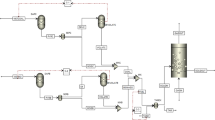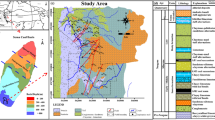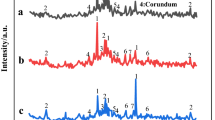Abstract
The spontaneous combustion period of coal in deep mines is short, so the risk of coal spontaneous combustion (CSC) is high, and it is cause environmental pollution. To explore the relationships between the microstructure and thermal effect of coal in deep mine, the relation among microstructure, activation energy and thermal effect of CSC was analysed using differential scanning calorimetry, Fourier infrared spectroscopy and synchronous thermal analyser, respectively. Results show that the process of coal self-combustion can be divided into 3 stages: the slow oxidation stage, accelerated oxidation stage and rapid combustion stage. In the slow oxidation stage, the XJL coal sample experienced the largest thermal release, and the main functional group was C–H–. In the accelerated oxidation and rapid combustion stages, the ZL coal experienced the largest thermal release; the functional groups are mainly C=C, –CH3, –CH2. In simpler terms, aromatic hydrocarbon significantly impacts the heating process of TK coal combustion. The structure of these hydrocarbons shows the highest correlation with the thermal release, followed by oxygen-containing functional groups for gas coal. These findings can help manage the risks of CSC and prevent potential dangers.
Graphical abstract









Similar content being viewed by others

References
Jia HL, Yang Y, Ren WX, Kang ZH, Shi JT. Experimental study on the characteristics of the spontaneous combustion of coal at high ground temperatures. Combust Sci Technol. 2021;194:1–14.
Chao JK, Gu QY, Pan RK, Han XF, Hu DM, Liu W, et al. Influence of a high-temperature environment in deep mining on the characteristics of coal spontaneous combustion. Combust Sci Technol. 2022. https://doi.org/10.1080/00102202.2022.2093110.
Yan L, Wen H, Liu WY, Jin YF, Liu Y, Li CS. Adiabatic spontaneous coal combustion period derived from the thermal effect of spontaneous combustion. Energy. 2022;239(15):122101. https://doi.org/10.1016/j.energy.2021.122101.
Wang CP, Deng Y, Xiao Y, Deng J, Shu CM, Jiang ZG. Gas-heat characteristics and oxidation kinetics of coal spontaneous combustion in heating and decaying processes. Energy. 2022;250(1):123810. https://doi.org/10.1016/j.energy.2022.123810.
Wang CP, Deng Y, Zhang YT, Xiao Y, Deng J, Shu CM. Coal oxidation characteristics and index gases of spontaneous combustion during the heating and cooling processes. Fuel. 2022;307:121806. https://doi.org/10.1016/j.fuel.2021.121806.
Ren SJ, Ma T, Zhang YN, Deng J, Xiao Y, Zhai XW, et al. Sound absorption characteristics of loose bituminous coal porous media with different metamorphic degrees. Fuel. 2023;332:126091. https://doi.org/10.1016/j.fuel.2022.126091.
Liu ZJ, Xu YL, Wen XL, Lv ZG, Wu JD, Li MJ, et al. Thermal properties and key groups evolution of low-temperature oxidation for bituminous coal under lean-oxygen environment. ACS Omega. 2021;6(23):15115–25.
Wang LB, Tsai YT, Liu SH, Deng J, Xiao Y, Wang QH, et al. Effects of 1-butyl-3-methylimidazolium nitrate on the thermal hazardous properties of lignitous and long flame coal through a green approach and thermokinetic models. Process Saf Environ Prot. 2019;131:127–34.
Jia HL, Yang Y, Ren WX, Kang ZH, Shi JT. Experimental study on the characteristics of the spontaneous combustion of coal at high ground temperatures. Combust Sci Technol. 2021;194(14):2880–93.
Yan L, Wen H, Liu WY, Jin YF, Liu Y, Li CS. Adiabatic spontaneous coal combustion period derived from the thermal effect of spontaneous combustion. Energy. 2021;239:122101. https://doi.org/10.1016/j.energy.2021.122101.
Liu WZ, Guo ZP, Wang C, Niu SW. Physico-mechanical and microstructure properties of cemented coal Gangue-Fly ash backfill: effects of curing temperature. Constr Build Mater. 2021;299(13):124011. https://doi.org/10.1016/j.conbuildmat.2021.124011.
Xiao Y, Guo T, Shu CM, Li QW, Li DJ, Chen LG. Effects of oxygen concentrations on the coal oxidation characteristics and functional groups. J Therm Anal Calorim. 2020;142(2):899–912.
Li H, Shi SL, Lin BQ, Lu JX, Ye Q, Lu Y, et al. Effects of microwave-assisted pyrolysis on the microstructure of bituminous coals. Energy. 2019;187(15):1–14.
Zhang YB, Zhang YT, Li YQ, Shi XQ, Xia SW, Guo Q. Determination and dynamic variations on correlation mechanism between key groups and thermal effect of coal spontaneous combustion. Fuel. 2021;310:122454. https://doi.org/10.1016/j.fuel.2021.122454.
Zhou CS, Zhang YL, Wang JF, Xue S, Wu JM, Chang LP. Study on the relationship between microscopic functional group and coal mass changes during low-temperature oxidation of coal. Int J Coal Geol. 2017;171(15):212–22.
Qi XY, Chen LZ, Zhang LB, Bai CW, Xin HH, Rao Z. In situ FTIR study on real-time changes of active groups during lignite reaction under low oxygen concentration conditions. J Energy Inst. 2019;92(5):1557–66.
Li JH, Li ZH, Yang YL, Zhang XY. Study on the generation of active sites during low-temperature pyrolysis of coal and its influence on coal spontaneous combustion. Fuel. 2019;241:283–96.
Liu Q, Lin BQ, Zhou Y, Zheng YN. The evolution law of functional groups during the heating of coal in oxygen and oxygen-free atmospheres. Greenh Gases: Sci Technol. 2021;11(2):266–76.
Zhou BZ, Yang SQ, Jiang XY, Cai JW, Xu Q, Song WX, et al. The reaction of free radicals and functional groups during coal oxidation at low temperature under different oxygen concentrations. Process Saf Environ Prot. 2021;150:148–56.
Zhao JY, Zhang YL, Song JJ, Zhang TH, Ming HQ, Lu SP, et al. Microstructure of coal spontaneous combustion in low-oxygen atmospheres at characteristic temperatures. Fuel. 2022;309:122132. https://doi.org/10.1016/j.fuel.2021.122132.
Meng XL, Zhang GF, Chu RZ, Wu GG, Gao MQ, Dai JZ, et al. Evolution mechanism of active groups and thermal effects of Chinese lignite in low-temperature oxidation. Chem Eng Commun. 2019;207(6):861–70.
Zhang YT, Yang CP, Li YQ, Huang Y, Zhang J, Zhang YB, et al. Ultrasonic extraction and oxidation characteristics of functional groups during coal spontaneous combustion. Fuel. 2019;242:287–94.
Ma T, Li MJ, Xu JL, Cao F. Thermodynamic analysis and performance prediction on dynamic response characteristic of PCHE in 1000 MW S-CO2 coal fired power plant. Energy. 2019;175(15):123–38.
Lou HZ, Jia TG. Study on thermal characteristics of coal spontaneous combustion in gas atmosphere by TG-DSC coupling techniques. China Saf Sci J. 2019;29(11):77–82.
Sun SL, Qiao H, Wei YJ, Wang SY. A new dynamic integrated approach for wind speed forecasting. Appl Energy. 2017;197(1):151–62.
Wang ZW, Lei TZ, Chang X, Shi XG, Xiao J, Li ZF, et al. Optimization of a biomass briquette fuel system based on grey relational analysis and analytic hierarchy process: a study using cornstalks in China. Appl Energy. 2015;157(1):523–32.
Lin CS, Lou FM, Huang CP. Grey forecasting model for CO2 emissions: a Taiwan study. Adv Mater. 2011;88(11):3816–20.
Zhang D, Cen XX, Wang WF, Deng J, Wen Hu, Xiao Y. Gray correlation analysis of CO generation pattern during process of low-temperature spontaneous combustion of jurassic coal. Combust Sci Technol. 2021. https://doi.org/10.1080/00102202.2021.2010721.
Zhao JY, Wang T, Deng J, Shu CM, Zeng Q, Guo T, et al. Micro characteristic analysis of CH4 emissions under different conditions during coal spontaneous combustion with high-temperature oxidation and in situ FTIR. Energy. 2020;209(15):118494. https://doi.org/10.1016/j.energy.2020.118494.
Jing MY, Dong C, Sun HB. Grey correlation analysis of influencing factors mass of coal spontaneous combustion. Saf Coal Min. 2011. https://doi.org/10.13347/j.cnki.mkaq.2012.12.053.
Wang CP, Hou YN, Xiao Y, Deng J, Shu CM, Xie XJ. Intrinsic characteristics combined with gaseous products and active groups of coal under low-temperature oxidation. Combust Sci Technol. 2020;193(15):2623–42.
Zhao JY, Deng J, Chen L, Wang T, Song JJ, Zhang YN, et al. Correlation analysis of the functional groups and exothermic characteristics of bituminous coal molecules during high-temperature oxidation. Energy. 2019;181(15):136–47.
Zhang YN, Hou YC, Zhao JY, Deng J, Wen XY, Liu CH, et al. Heat release characteristic of key functional groups during low-temperature oxidation of coal. Combust Sci Technol. 2020;193(15):2692–703.
Ma L, Yu WC, Ren LF, Qin XY, Wang QH. Micro-characteristics of low-temperature coal oxidation in CO2/O2 and N2/O2 atmospheres. Fuel. 2019;246(15):259–67.
Chang KT, Chang FP. Optimization of the WEDM process of particle-reinforced material with multiple performance characteristics using grey relational analysis. J Mater Process Technol. 2006;180(1–3):96–101.
Li PP, Zhang XD, Li J, Zhao JP, Huang JP, Zhang S, et al. Analysis of the key factors affecting the productivity of coalbed methane wells: a case study of a high-rank coal reservoir in the central and southern Qinshui Basin China. ACS Omega. 2020;5(43):28012–26.
Li PP, Zhou SX, Zhang XD, Li J, Zhang S, Hou AQ, et al. Analysis on correlation between nonporous and coal compositions during thermal maturation process. Mar Pet Geol. 2020;121:104608. https://doi.org/10.1016/j.marpetgeo.2020.104608.
Ren SJ, Wang CP, Xiao Y, Deng J, Tian Y, Song JJ, et al. Thermal properties of coal during low temperature oxidation using a grey correlation method. Fuel. 2020;260:116287. https://doi.org/10.1016/j.fuel.2019.116287.
Chen C, Tang Y, Guo X. Comparison of structural characteristics of high-organic-sulfur and low-organic-sulfur coal of various ranks based on FTIR and Raman spectroscopy-science direct. Fuel. 2021;310:122362. https://doi.org/10.1016/j.fuel.2021.122362.
Ren LF, Deng J, Li QW, Ma L, Zou L, Wang LB, et al. Low-temperature exothermic oxidation characteristics and spontaneous combustion risk of pulverized coal. Fuel. 2019;252(15):238–45.
Qi GS, Wang DM, Zheng KM, Xu J, Qi XY, Zhong XX. Kinetics characteristics of coal low-temperature oxidation in oxygen-depleted air. J Loss Prev Process Ind. 2015;35:224–31.
Deng J, Bai ZJ, Xiao Y, Shu CM. Effects on the activities of coal microstructure and oxidation treated by imidazolium-based ionic liquids. J Therm Anal Calorim. 2018;133:453–63.
Acknowledgements
This work was supported by the National Natural Science Foundation of China (Nos. 5217-4201, 5207-4215), the Shaanxi Science Fund for Distinguished Young Scholars (2022JC-30) and Shaanxi Province “Special Support Program for High-leve1 Talents” Young Top Talent.
Author information
Authors and Affiliations
Contributions
JD was involved in supervision, writing—reviewing and editing, and validation. NNY was responsible for conceptualisation, methodology and writing—original draft preparation. CPW took part in supervision and data curation. ZJB, XYZ and QG contributed to supervision. YD and DX carried out investigation.
Corresponding authors
Ethics declarations
Conflict of interest
We declare that we have no financial and personal relationships with other people or organisations that can inappropriately influence our work, there is no professional or other personal interest of any nature or kind in any product, service or company that could be construed as influencing the position presented in, or the review of, the manuscript entitled, “Influence of microstructure characteristics of deep mine coal on oxidation heat effect”.
Additional information
Publisher's Note
Springer Nature remains neutral with regard to jurisdictional claims in published maps and institutional affiliations.
Rights and permissions
Springer Nature or its licensor (e.g. a society or other partner) holds exclusive rights to this article under a publishing agreement with the author(s) or other rightsholder(s); author self-archiving of the accepted manuscript version of this article is solely governed by the terms of such publishing agreement and applicable law.
About this article
Cite this article
Deng, J., Yang, N., Wang, C. et al. Influence of microstructure characteristics of deep mine coal on oxidation heat effect. J Therm Anal Calorim 148, 11053–11068 (2023). https://doi.org/10.1007/s10973-023-12420-w
Received:
Accepted:
Published:
Issue Date:
DOI: https://doi.org/10.1007/s10973-023-12420-w



